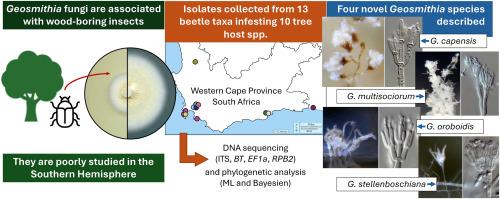Four new Geosmithia species from bark beetles infesting indigenous South African trees
IF 2.9
3区 生物学
Q2 MYCOLOGY
引用次数: 0
Abstract
Over the past two decades, numerous Geosmithia fungi have been isolated from the bodies and galleries of wood–boring beetles. However, this genus of asexual Sordariomycetes remains taxonomically and ecologically understudied, especially in the Southern Hemisphere. In South Africa, two prior surveys reported Geosmithia species from bark beetles, but neither thoroughly investigated species identities. In this study, we collected bark beetles from native trees in the Western Cape Province of South Africa and isolated, identified and described their associated Geosmithia species. Geosmithia spp. previously collected in South Africa were also re-examined. The ITS sequences of Geosmithia isolates from 13 beetle taxa infesting 10 host species were considered. Additional gene regions, BT, EF1a and RPB2, were sequenced for a subset of isolates. Four previously described species, G. flava, G. langdonii, G. omnicola and G. pumila were identified by phylogenetic analyses. Additionally, four novel taxa were identified and are here described as G. capensis, G. multisociorum, G. oroboidis and G. stellenboschiana. Geosmithia multisociorum appears to be a generalist associated with multiple beetle–host combinations in the Northern and Southern Hemisphere, whereas G. oroboidis is currently known only from a single beetle and tree host in South Africa. South African isolates of G. capensis and G. stellenboschiana appeared to be restricted to Lanurgus spp. and Hypothenemus sp. beetles, respectively, but both species are also known from beetles and hosts in other countries.

从侵扰南非本土树木的树皮甲虫中发现 4 个 Geosmithia 新种
在过去的二十年里,从蛀木甲虫的尸体和虫廊中分离出了大量的 Geosmithia 真菌。然而,对这一无性真菌属在分类学和生态学方面的研究仍然不足,尤其是在南半球。在南非,之前的两次调查报告了树皮甲虫中的 Geosmithia 物种,但都没有彻底调查物种特征。在这项研究中,我们从南非西开普省的本地树木中采集了树皮甲虫,并分离、鉴定和描述了与之相关的 Geosmithia 物种。我们还重新研究了以前在南非收集到的 Geosmithia 属种。考虑了从侵扰 10 个寄主物种的 13 个甲虫类群中分离出的 Geosmithia 的 ITS 序列。对部分分离物的其他基因区域(BT、EF1a 和 RPB2)进行了测序。通过系统发育分析,确定了四个以前描述过的物种:G. flava、G. langdonii、G. omnicola 和 G. pumila。此外,还发现了四个新的类群,分别为 G. capensis、G. multisociorum、G. oroboidis 和 G. stellenboschiana。Geosmithia multisociorum 似乎是一种与南北半球多种甲虫寄主组合相关的通性种,而 G. oroboidis 目前仅从南非的一种甲虫和树木寄主中获知。南非的 G. capensis 和 G. stellenboschiana 分离物似乎分别局限于 Lanurgus spp.和 Hypothenemus sp.甲虫,但这两个物种在其他国家的甲虫和寄主中也有发现。
本文章由计算机程序翻译,如有差异,请以英文原文为准。
求助全文
约1分钟内获得全文
求助全文
来源期刊

Fungal biology
MYCOLOGY-
CiteScore
5.80
自引率
4.00%
发文量
80
审稿时长
49 days
期刊介绍:
Fungal Biology publishes original contributions in all fields of basic and applied research involving fungi and fungus-like organisms (including oomycetes and slime moulds). Areas of investigation include biodeterioration, biotechnology, cell and developmental biology, ecology, evolution, genetics, geomycology, medical mycology, mutualistic interactions (including lichens and mycorrhizas), physiology, plant pathology, secondary metabolites, and taxonomy and systematics. Submissions on experimental methods are also welcomed. Priority is given to contributions likely to be of interest to a wide international audience.
 求助内容:
求助内容: 应助结果提醒方式:
应助结果提醒方式:


